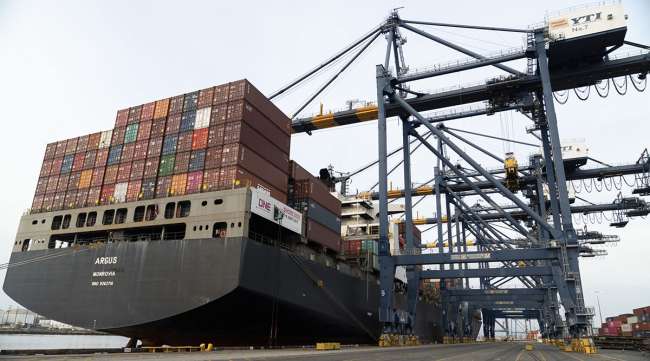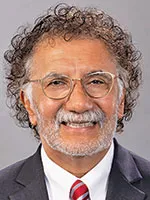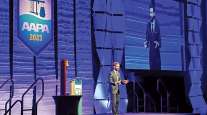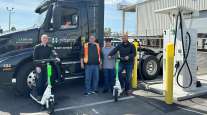Bloomberg News
California Ports Deploying Air Pollution Capture for Ships

[Stay on top of transportation news: Get TTNews in your inbox.]
At first glance, the ports of Los Angeles and Long Beach look like any others in the world. Among the world’s busiest, the neighboring facilities hum with massive containerships, tankers and auto carriers making their way in and out, and cranes swinging containers onto waiting trucks.
But at the Port of L.A., a curious companion is making itself at home next to docked boats: a bright green barge with a massive 270-foot bendable arm hovering over a container vessel’s smokestack holding a system of hoses, filters and pumps collecting exhaust like a giant range hood.
Maritime shipping isn’t just a major source of carbon dioxide emissions. The industry is also responsible for air pollution that can harm the health of those living near ports. The green barge is one startup’s attempt to address the problem at its source, though the company behind it has a ways to go in deploying its technology at meaningful scale.
Long Beach, Calif.-based startup Stax Engineering has deployed its pollution-capturing tech at multiple ports for the first time, to service vessels at the ports of L.A., Long Beach and Oakland. The system is powered by renewable diesel and is designed to capture and filter exhaust from containerships and auto carriers, removing 99% of diesel particulate matter and 95% of nitrogen oxide. It then releases pollution-stripped gas that’s a mixture that includes CO2 and water vapor.
Air pollution is a major contributor to negative health outcomes, particularly for disadvantaged communities often located near ports. The tiny particles emitted by ships, as well as by cars and factories, contribute to millions of deaths annually and cost billions of dollars in medical care and missed work. The ports of L.A. and Long Beach alone produce about 100 tons of smog daily, an amount greater than the emissions of 6 million cars, according to the Environmental and Energy Study Institute.
To address this, the California Air Resources Board instituted regulations that certain oceangoing vessels must reduce their emissions while at berth by at least 80%. One way of doing so is connecting to shoreside electrical power via an extension cord, which allows ships to turn off their exhaust-emitting auxiliary engines. The regulations will result in a 90% reduction in pollution and a 55% reduction in potential cancer risk for communities near the ports, according to CARB’s analysis.

Cordero
But getting the emissions-reduction technology and infrastructure ready to do this, especially for larger ships like bulk vessels, tankers and auto carriers, is a challenge that’s “going to take some time,” said Port of Long Beach CEO Mario Cordero at the BloombergNEF Summit in January. Vessels, as well as terminals, need to be retrofitted to allow for shore power connection, which is an expensive and time-intensive task.
Stax’s system is an alternative for those vessels that either don’t have existing shore power capabilities or aren’t able to be retrofitted, according to CEO Mike Walker. “Shore power will ultimately build as they can fund [systems] and build them,” he said. “Capture and control is going to come in and fill that gap in the meantime.”
So far, the company’s barge in the ports of L.A. and Long Beach has treated 44 vessels, with a capacity of servicing 146 ships annually. That’s a tiny proportion, though, of the nearly 4,000 vessels that call at these ports yearly.
CARB regulations currently apply to containerships throughout California but are set to expand to include auto carriers in 2025 and tankers in 2027. About 15% of container vessels are equipped with shore power connections, and about 68% of containerships connected to the ports’ shore power systems or employed an equivalent method in the Port of L.A. in 2021, according to a 2022 report from the Environmental Protection Agency.
Whether or not ships install equipment to tap shore power depends on how often they call at California’s ports; for those who make frequent trips, it might make more economic sense than it would for one-off visitors. Capture-and-control technology could be an ideal solution for the latter, particularly given the hefty fine for carriers that flout the CARB regulations.
How does hydrogen fuel cell technology fit into freight transportation? Find out with Parker Meeks, the CEO of Hyzon, a company that designs and manufactures fuel cell technology for heavy-duty transport applications. Tune in above or by going to RoadSigns.ttnews.com.
Installing shore power infrastructure is “very expensive,” Michael DiBernardo, the deputy executive director of marketing and customer relations at the Port of L.A., said at the BNEF Summit. The cost to do so is “in the neighborhood of around $20 million to bring in that electrical infrastructure to plug in the ship.”
That’s why the industry is looking at alternatives, he added.
Ultimately, both shore power and capture-and-control are bridge solutions, as the maritime shipping industry makes its slow transition to cleaner fuels like methanol and ammonia. But that green transition takes time, and in the meantime, carriers need a way to cut emissions from their aging and costly-to-retrofit vessels.
Stax charges carriers an hourly fee to use the system, which is the first to be authorized to service both container vessels and auto carriers at these two ports. It’s also currently testing its technology on tanker-class vessels, which usually have multiple exhaust points including engines as well as boilers, which it expects CARB to authorize for use later this year. Stax is also awaiting authorization to operate a second barge at the Port of Oakland. Currently, two other companies — Aeras Technologies and Clean Air Engineering-Maritime — are authorized to service container vessels at the ports of L.A. and Long Beach with capture-and-control systems.
Although most ports outside of California don’t have the Golden State’s strict emissions and air pollution standards, Walker said he has been approached by carriers interested in implementing the technology elsewhere at the urging of their ESG-focused investors and boards. And he sees California leading the way in limiting smog from oceangoing vessels, just as it did in introducing strict smog standards for cars. That could eventually lead to “a global market” for emissions capture and control technology.
The company’s investors include actor and environmental activist Edward Norton, who also serves as board chair. It currently has two treatment barges with plans to have built 20 by 2025 at a cost of around $10 million per vessel. That would be enough to service every port in the state, according to Walker.
Want more news? Listen to today's daily briefing above or go here for more info
Stax’s ultimate goal, according to founder, President and Chief Technology Officer Bob Sharp, is to modify and upgrade its system to capture CO2 in addition to air pollution. The company was recently awarded a CARB technology grant, part of which entails a trial for carbon capture in addition to running safety tests on tankers.
Clean fuels such as methanol will be essential to helping the shipping industry reach its goal of net-zero emissions by 2050 set by the International Maritime Organization. But addressing emissions at port can play a role, especially with shipping-related emissions on track to rise as much as half by 2050 if left unchecked.
“What we have now is this network of distributed capture vehicles that will be pre-treating the NOx [nitrogen oxide] and PM [particulate matter] of all these vessels, and now we can build out a carbon solution,” Walker said.





